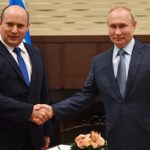
If anyone doubted Joe Biden’s early support for the war effort in Ukraine, the president has a number he’d like to show you: 33.
As in $33 billion, with a B.
The Biden administration in recent days has made plain its commitment to support Ukraine and bolster Eastern European allies for the long haul. And the decision to deploy 20,000 additional U.S. troops in response to the conflict — and possibly more in the weeks and months to come — has the potential to drastically alter the U.S. military footprint across Europe for decades to come.
Russia’s invasion of Ukraine has already induced some of the deepest revisions to European defense and security posture in at least a generation. But the $33 billion aid package the White House sent to Congress last month — added to the $3.4 billion already committed since Russia’s invasion — would transform and modernize both the Ukrainian and NATO militaries all at once, and is aimed at flushing the last remaining Russian military equipment from the alliance and severing many of the lingering industrial ties to Moscow.
These rapid-fire changes are coming amid hurried debates over the intentions of an unpredictable Vladimir Putin, whose state-controlled media is increasingly belligerent in calling for a wider war in Europe and suggesting that nuclear weapons be used in Ukraine.
“We want Ukraine to win this war,” European Commission President Ursula von der Leyen said in Brussels Wednesday. “But we also want to set the conditions for Ukraine’s success in the aftermath of the war.”
The Biden administration has moved quickly since February to put up money to help not only Ukraine, but also funnel financial assistance to small NATO countries to build up their defensive capabilities.
In the $713 million aid package announced by the White House in April, Estonia, Latvia and Lithuania will each receive $45 million in financing to buy American weaponry, capabilities those countries say they desperately need. Romania, Georgia, Bulgaria and other countries will also receive tens of millions in aid.
That money will help replace the remaining Russian military equipment still in use across Eastern Europe, which for years has been a major goal of NATO. And it will further isolate the Russian defense industry, which still holds some maintenance contracts supporting equipment in Europe.
The bulk of that package, which was announced before the administration asked Congress to approve the $33 billion in military and humanitarian aid on April 28, would earmark $322 million for Ukraine. Most of the money will “help the Ukraine Armed Forces transition to NATO systems” and away from Russian gear, a State Department document shared with POLITICO stated.
The new package includes more than $20 billion in new military and security assistance, which will go toward equipment such as drones and heavy artillery that will help Ukraine hold off Russian forces in the Donbas.
That aid will go a long way in getting more modern equipment on the battlefield, though the White House has avoided specifics as it waits for Congress to do its work. As older Russian equipment is being quickly shot off and worn out in Ukraine, it’s clear that NATO-grade gear will be the only alternative, something that Washington and its allies openly embrace.
The Ukrainians have publicized their wish list, which includes Harpoon anti-ship missiles, long-range drones for surveillance and strikes, and long-range rocket artillery such as High Mobility Artillery Rocket System and new air defense capabilities.
Even without specifics, the sheer dollar value of the commitment shows the Pentagon is preparing for what could be a long, drawn-out fight for the Donbas. Russian forces are moving to encircle Ukrainian troops there from the north, east and south out of Mariupol — but they are making slower progress than expected, officials say.
“Because the Donbas is a region that the Russians and the Ukrainians have experience fighting one another in, because the Russians are going to be concentrating now almost all of their remaining combat power in the south — and because Ukrainians have clearly shown no interest in capitulating and not fighting for every inch of their territory,” Pentagon press secretary John Kirby said on Monday, “there is a distinct possibility that this could go on for quite some time.”
The Pentagon has already bolstered its presence in Europe by roughly 20,000 more troops since the conflict began, Kirby said, noting that the increase is designed to help defend NATO territory, and isn’t directly tied to the fight in Ukraine.
Although the department has no announcements to make about additional changes, Defense Secretary Lloyd Austin has directed leaders to look at how U.S. military forces will be positioned in Europe in the future, Kirby said last week.
“The security environment has changed now in Europe,” Kirby said. “The secretary wants us to start thinking about what a European footprint should look like going forward.”
Defense officials from several countries have expressed surprise over how well the Ukrainians have fought, and also by how badly the Russian military has performed in the conflict, as Russian forces have been plagued by low morale and logistics challenges, communications failures, and their inability to accomplish any of their goals.
Ukrainian soldiers, by contrast, have put up stiff resistance. They have benefited not only from experience gained during eight years of combat against Russian-backed separatists in the Donbas, but also from Western equipment and having trained alongside NATO forces since Russia’s 2014 invasion of Crimea.
“The worst thing the Russians did was give us eight years to prepare,” Brig. Gen. Joseph Hilbert of 7th Army Training Command said on Wednesday.
The Pentagon is also preparing for the knock-on effect a prolonged conflict could have on the U.S. defense industrial base. The proposal includes $5.4 billion to replenish DoD stockpiles of weapons and equipment sent to Ukraine, and Pentagon officials are in discussions with industry about how to supercharge these production lines.
Industry has warned of the challenges of continuing to support the conflict. Raytheon Technologies, which produces the Stinger, suggested last week that resuming production once existing inventory is depleted could be difficult.
Still, Austin told lawmakers on Tuesday that he “won’t allow” critical munitions to fall below minimum levels.
If the Kremlin miscalculated that the war in Ukraine would be over within days, an equally poor assumption was that NATO would stand by helplessly. Instead, the alliance as well as the EU have rowed in the same direction, flowing aid and equipment into Ukraine, and slapping increasingly harsh sanctions on Russia’s economy and ruling class.
The invasion has pushed Germany to toss aside its decades-old policy of refusing to arm warring countries, and has led Finland and Sweden to prepare to apply for NATO membership, a prospect that would double Russia’s borders with the Western military alliance, seeing it stretch from the Arctic to the Baltic seas.
“There is no going back,” Finnish Prime Minister Sanna Marin said in remarks after meeting with German Chancellor Olaf Scholz and Swedish Prime Minister Magdalena Andersson this week. “Russia’s attack on Ukraine has changed our security environment completely.”
Scholz said Germany would fully back the applications of both countries if they are submitted this month, as is widely expected.
Bringing aboard these new members will no doubt dominate the NATO summit in Madrid scheduled for the end of June. The agenda will also be packed with discussion about the unveiling of a new strategic concept for the first time since 2010, the massive amounts of money member nations are pouring into their defense budgets, and calls by Baltic and Black Sea nations for a beefed-up NATO presence in their countries.
The issues are as weighty and transformative as any the alliance has grappled with in its 73-year history. Estonia has already gone public with calls for a full division’s worth of NATO troops to be housed within its borders, while Latvia and Lithuania are seeking similar assurances as they look to restock the hundreds of Stinger and Javelin missiles they rushed to Ukraine early in the war.
“Certainly the changes taking place now can be compared to the developments that took place back in 1989 and 1991,” when the Soviet Union collapsed, Lithuanian Defense Minister Arvydas Anušauskas told POLITICO. The difference is that collapse began a process of disarmament and drift among NATO countries. But “now the situation is different because of the threat posed by Russia,” Anušauskas said, adding the alliance is focused in a way he’s never seen before.
Lithuania is looking for more NATO troops, but has also recently allocated $2 billion to be spent on U.S. and German weaponry, including loitering munitions, armored vehicles, and multiple launch rocket systems that will be shared among the three Baltic countries.
“Ukraine is fighting for our security in Europe,” one NATO diplomat who requested anonymity to speak about the war told POLITICO. That change is felt acutely along NATO’s eastern front, where Poland is acting as a transit point for Western arms into Ukraine, and has committed to increasing its defense budget from the current 2 percent to 3 percent of the country’s GDP.
“We think it’s time to move on from this forward presence concept based on the tripwire approach,” the NATO diplomat said, where a small number of NATO troops are stationed in Eastern Europe, to a larger footprint that could actually halt any Russian incursion. The idea is to move from “deterrence by punishment to deterrence by denial,” the official said.
Those efforts will not only help defeat Russia on the battlefield, but suffocate its economy and weaken its military for years to come, Celeste Wallander, who runs the International Security Affairs office at the Pentagon, said Monday at an event hosted by the Atlantic Council. “The U.S. government’s objective in this crisis relative to Russia … is that Russia ends this crisis as a strategic failure.”




